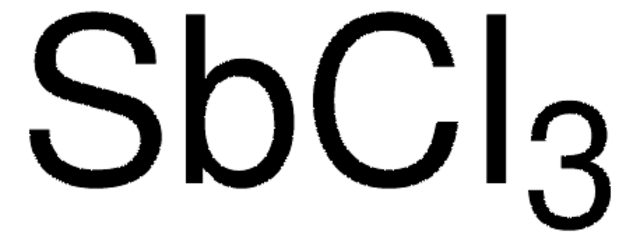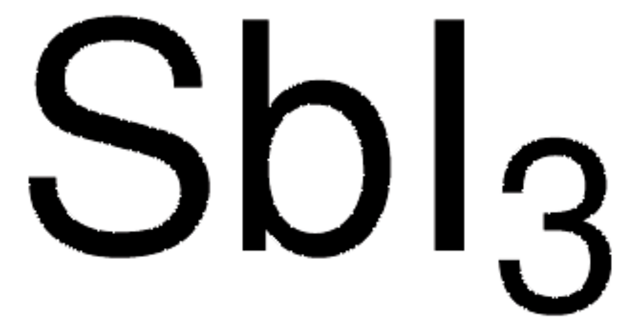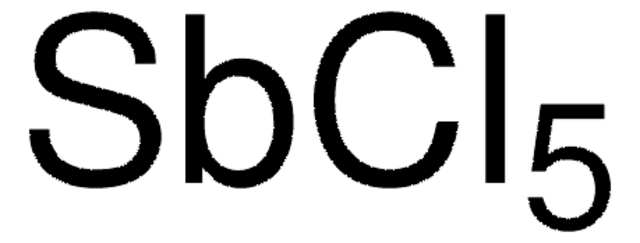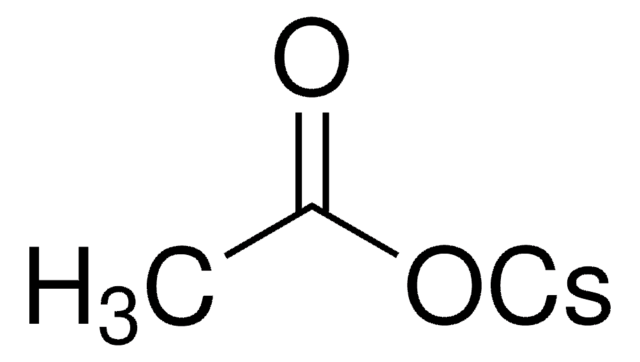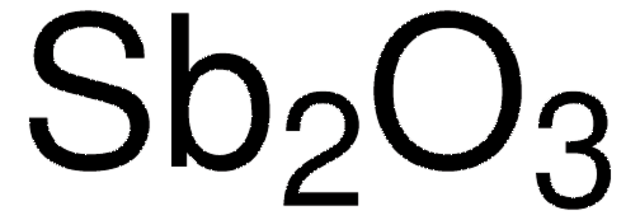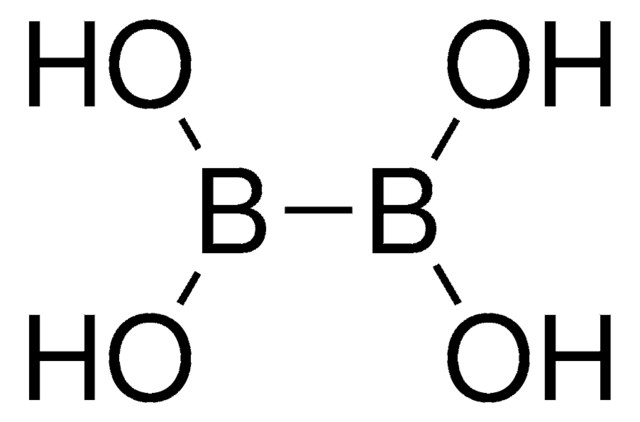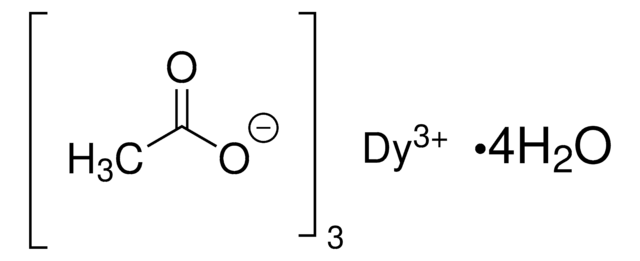483265
Antimony(III) acetate
99.99% trace metals basis
Sinônimo(s):
Antimony acetate, Antimony triacetate, Triacetoxystibine
Faça loginpara ver os preços organizacionais e de contrato
About This Item
Fórmula linear:
(CH3CO2)3Sb
Número CAS:
Peso molecular:
298.89
Número CE:
Número MDL:
Código UNSPSC:
12352103
ID de substância PubChem:
NACRES:
NA.23
Produtos recomendados
Nível de qualidade
Ensaio
99.99% trace metals basis
Formulário
solid
adequação da reação
core: antimony
reagent type: catalyst
pf
126-131 °C (lit.)
densidade
1.22 g/mL at 25 °C (lit.)
cadeia de caracteres SMILES
CC(=O)O[Sb](OC(C)=O)OC(C)=O
InChI
1S/3C2H4O2.Sb/c3*1-2(3)4;/h3*1H3,(H,3,4);/q;;;+3/p-3
chave InChI
JVLRYPRBKSMEBF-UHFFFAOYSA-K
Categorias relacionadas
Descrição geral
Antimony(III) Acetate is an is a high-purity compound (99.9% trace metals basis) that is widely used as a precursor in chemical vapor deposition (CVD) and Sol-gel atomic layer deposition (ALD) methods for the fabrication of antimony-based thin films, which are used in optoelectronic devices, including solar cells, and photodetectors. It is also employed as a dopant in semiconductor materials to modify their electrical and optical properties. Additionally, it serves as a catalyst in polymerization reactions and utilized in the synthesis of antimony-based nanoparticles and nanostructures, which find applications in energy storage systems such as batteries and supercapacitors.
Aplicação
- New Complexes of Antimony(III) with Tridentate O,E,O-Ligands: Explores new antimony(III) complexes providing insights into their bonding and potential applications in materials science (U Böhme, M Herbig, 2023).
- Antimony (III) acetate as a catalyst for synthesis of xanthenes: Details the use of antimony(III) acetate as a catalyst in the synthesis of biologically active compounds, showcasing its efficiency in organic chemistry (F Hakimi, A Hassanabadi, 2015).
Características e benefícios
Antimony(III) acetate exhibits:
- 99.99% trace metals basis (<150 ppm) ensures minimal contamination with consistent performance in critical applications, leading to better outcomes.
- Suitable catalyst to produce synthetic fibres. It is moderately soluble in water
- Suitable for solvent free reactions.
Palavra indicadora
Warning
Frases de perigo
Declarações de precaução
Classificações de perigo
Acute Tox. 4 Inhalation - Acute Tox. 4 Oral - Aquatic Chronic 2
Código de classe de armazenamento
11 - Combustible Solids
Classe de risco de água (WGK)
WGK 2
Ponto de fulgor (°F)
Not applicable
Ponto de fulgor (°C)
Not applicable
Escolha uma das versões mais recentes:
Já possui este produto?
Encontre a documentação dos produtos que você adquiriu recentemente na biblioteca de documentos.
Os clientes também visualizaram
Dandan Xie et al.
Nanoscale, 10(30), 14546-14553 (2018-07-20)
(Ag,Sn) co-doped Cu3SbSe4 nanocrystals are obtained via a facile microwave-assisted solvothermal method, and their thermoelectric properties are investigated in the temperature range from 300 K to 623 K. Sn-doping on Sb sites dramatically increases the carrier concentration and thus the
Yosra Chebbi et al.
Polymers, 11(3) (2019-04-10)
In this study, the synthesis of poly(ethylene furanoate) (PEF), catalyzed by five different catalysts-antimony acetate (III) (Sb Ac), zirconium (IV) isopropoxide isopropanal (Zr Is Ip), antimony (III) oxide (Sb Ox), zirconium (IV) 2,4-pentanedionate (Zr Pe) and germanium (IV) oxide (Ge
Wasim J Mir et al.
Scientific reports, 7(1), 9647-9647 (2017-08-31)
We investigate the potential use of colloidal nanoplates of Sb
Xiao-Ling Qu et al.
ChemSusChem, 12(22), 4927-4935 (2019-09-05)
Green synthesis of bioderived high-molecular-weight poly(ethylene 2,5-furandicarboxylate) (PEF) over metal-free catalysts is a significant challenge. This study focuses on PEF prepared from ethylene glycol and 2,5-furandicarboxylic acid (FDCA) through a direct esterification method with ecofriendly metal-free ionic liquids (ILs) as
Tianxin Bai et al.
Advanced materials (Deerfield Beach, Fla.), 33(8), e2007215-e2007215 (2021-01-21)
The colloidal synthesis of a new type of lead-free halide quadruple-perovskite nanocrystals (NCs) is reported. The photoluminescence quantum yield and charge-carrier lifetime of quadruple-perovskite NCs can be enhanced by 96 and 77-fold, respectively, via metal alloying. Study of charge-carrier dynamics
Global Trade Item Number
| SKU | GTIN |
|---|---|
| 483265-100G | 4061832389943 |
| 483265-500G |
Nossa equipe de cientistas tem experiência em todas as áreas de pesquisa, incluindo Life Sciences, ciência de materiais, síntese química, cromatografia, química analítica e muitas outras.
Entre em contato com a assistência técnica